In Alaska village, a Native mother and disfigured son find salvation
For the mother of a boy born with Apert syndrome, going home to Klawock, Alaska, has given her son a chance and the care he needs for a normal life.
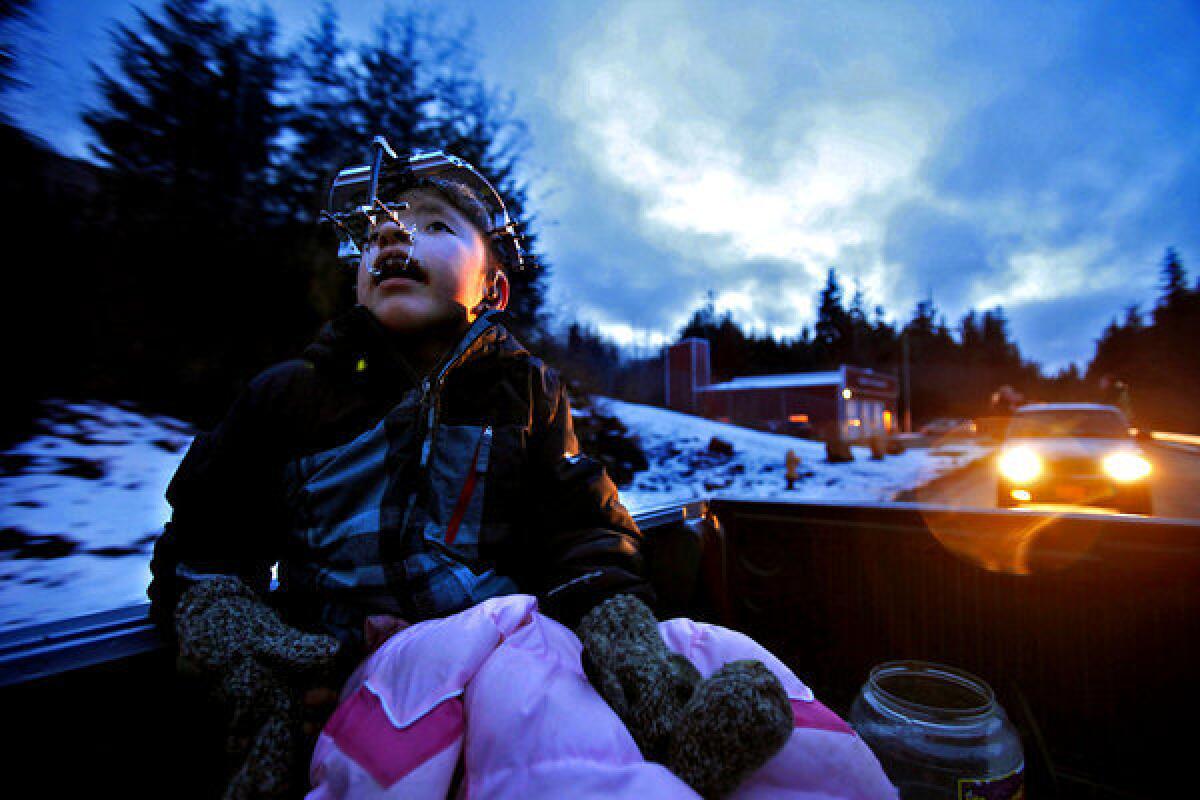
Kecia Weatherwax is convinced her son was healed not just by surgeons but also by this misty archipelago she sailed to all those years ago.
An Alaska village where a "mad Indian," as she describes herself, would be entitled to demand help for her Native child, born with a rare genetic mutation that gave him a misshapen head and bulging eyes.
A place where her father, a Tlingit elder and member of the tribal council, commanded the respect that led others to accept his grandson.
A town that had seen enough trouble to know that it didn't come in the shape of a small boy's face.
James was snatched away minutes after he was born, flown to a bigger hospital while Weatherwax was still on the delivery table. The tiny boy looked shocking, she said, even to the doctors who regularly delivered babies from troubled pregnancies on Montana's Blackfeet Indian Reservation.
"They hadn't seen anything like it, they couldn't even name it. His hands were tiny spatulas with no fingers, his feet were clubbed, he had a cleft palate. And his head, the whole top of it was bulging," says Weatherwax, who learned her son had Apert syndrome, a condition that fuses bone in the wrong places and can leave patients struggling to eat, hear and even breathe.
The years of surgeries he would require to live any kind of a normal life would cost hundreds of thousands of dollars.
"For me, it was like being skinned alive," Weatherwax remembers feeling as she contemplated returning to the impoverished Montana reservation with a child who needed so much.
Then it struck her: She needed to go home — to the remote island in the southeastern Alaska rain forests where she grew up, a place where the natives had parlayed the state's resource wealth into modern clinics and good hospitals.
With the baby on one arm and a toolbox stuffed with her clothes in the other, Weatherwax headed with her father for the coast and boarded a ferry for Alaska. When they arrived three days later, Jim Williams sat his daughter down with the soft smile she had come to know so well, cheerful and amiable on the outside, but under which was the resolve that has allowed the Tlingit to survive in this rough country for the last 10,000 years.
"Brace up," Williams told her. "Fly straight."

Klawock, a village of 850 set on Alaska's Prince of Wales Island, has always been famed for its majestic stands of spruce, snowcapped peaks and abundant runs of Pacific salmon. Several canneries, including Alaska's first, once lined the waterfront, but they closed long ago, along with the movie theater. What remains is a cluster of small, weathered houses, along with a lumber mill, grocery store, school and clinic.

James Weatherwax, 11, rides in the back of his grandfather's truck while participating in a celebratory parade through the town of Klawock, Alaska, honoring the Klawock High School basketball team, which won the state championship in March. More photos
Williams built the family's cramped, simple house with money he earned as a construction worker in Oakland in the 1960s. Now, it has to do duty for three generations: Weatherwax moved in a decade ago not just with James, but also an older daughter. Since then, she's had two more children. The small living room is a perpetual cacophony of shrieking toddlers and booming television cartoons, with uncles and aunts showing up periodically to scold or sit idly at the kitchen table.
Here, 11-year-old James is not a misfit. He rides shotgun in Williams' pickup on the way to the tribal council offices, climbs in the boat behind him to set skates for halibut and sways with his grandfather at ceremonial Tlingit dances.
When James was born, his grandfather just carried him around proudly. And because of that, he was always part of the community. Always."— Kay Schrammeck, special learning program coordinator
When James plays basketball or runs with his slow, web-footed gait at cross-country meets, Williams is in the stands cheering for him. They sleep together in Williams' big bed, and when James' raucous apnea snores pause for too long, his grandfather rouses him.
"When James was born, his grandfather just carried him around proudly. And because of that, he was always part of the community. Always," says Kay Schrammeck, who coordinates the special learning programs that help James read despite his poor hearing and uncoordinated eye focus.
The early days were some of the hardest, Weatherwax says. James' tiny body was racked by seizures. "His brain didn't have room to grow in his head, and it was compressed, I could tell: I would hold him, and he would just start twitching in my arms," she says. "He was hurting."
But when she took the baby to the local Native health clinic upon returning to Alaska, the nurse even there shrugged dismissively, making it clear there were no surgical facilities to correct defects so profound. "What do you want me to do?" the woman said.
Weatherwax felt a fury rising in her. "I expect you to help us," she said.
Desperate to stop the seizures, Weatherwax traveled to a clinic in Juneau. There, doctors said funds were available for her to take James to Children's Hospital in Seattle, which has a craniofacial surgical unit accustomed to dealing with conditions as rare as Apert syndrome, which occurs in 1 out of every 100,000 births.
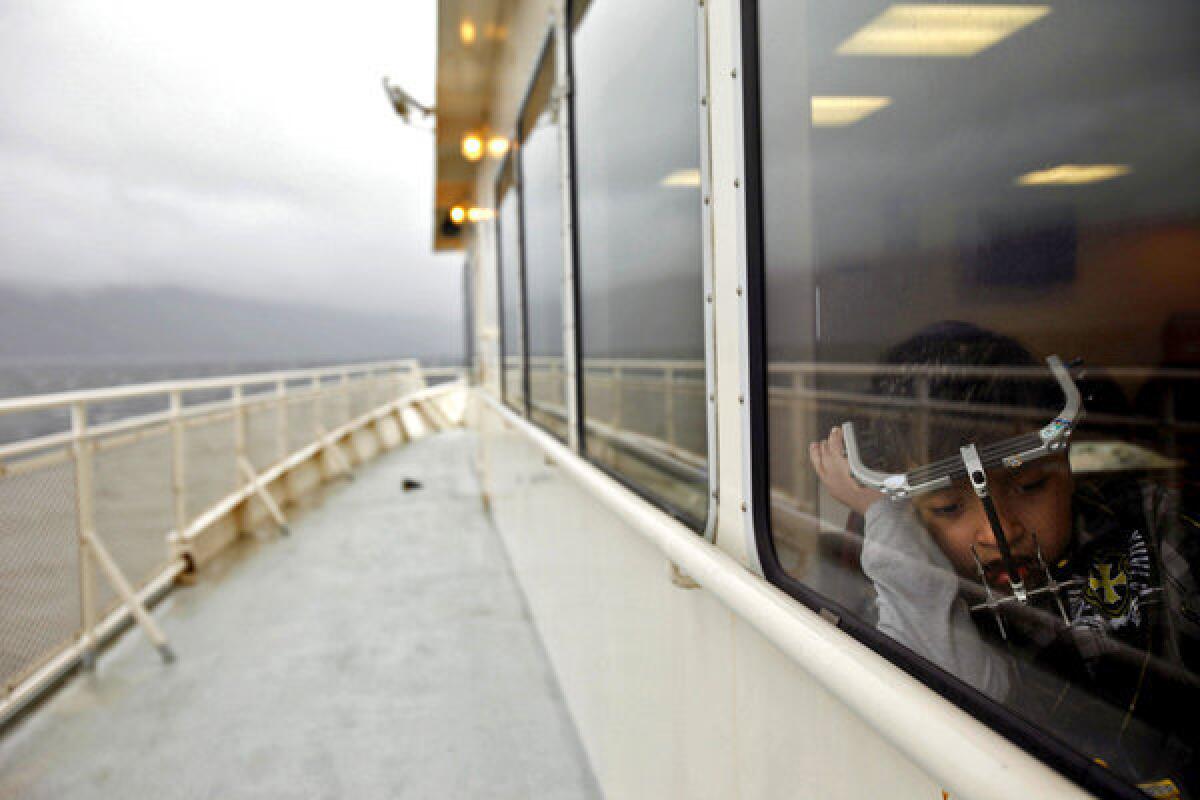
James spends a quiet moment during a 3 1/2-hour ferry ride from Hollis to Ketchikan in Alaska. From there, he and his mother, Kecia, will take a plane to Seattle. More photos
The frequent trips — more than a dozen surgeries so far, plus follow-up visits — are arduous. Just getting to Seattle involves a half-hour drive to the port, a 3 1/2 -hour ferry ride to Ketchikan, then another short ferry ride and a two-hour flight.
The doctors in Seattle performed the first of what would become a long series of surgeries to split James' hands into fingers, close his palate, open his ears. When he was 2, doctors sliced open his skull from ear to ear and opened a space big enough for his growing brain, filling in the gap at the top of his head with grafts from his tiny ribs.
But he still looked odd — his eyes, with almost no sockets, projected strangely and could hardly close. His head ballooned up over his eyebrows.
When Weatherwax left the village briefly to take a job as a grant writer in Fairbanks, kids on the playground there struck up a game of tag and made James "it" because he was "a monster."
"I want to say, 'Where's your mom at? I'm going to go beat the hell out of her.'"
Klawock was more accepting — maybe because James' grandfather was so influential. Maybe because it is a rough town where a lot worse things than Apert syndrome can happen to people. Williams counts five people among his neighbors who've shot themselves; five of his uncles died on a skiff after trying to make their way home drunk. Weatherwax's best friend drove inebriated off the road and drowned after she was thrown out of her car into a ditch.
"People made bad choices," Williams says.
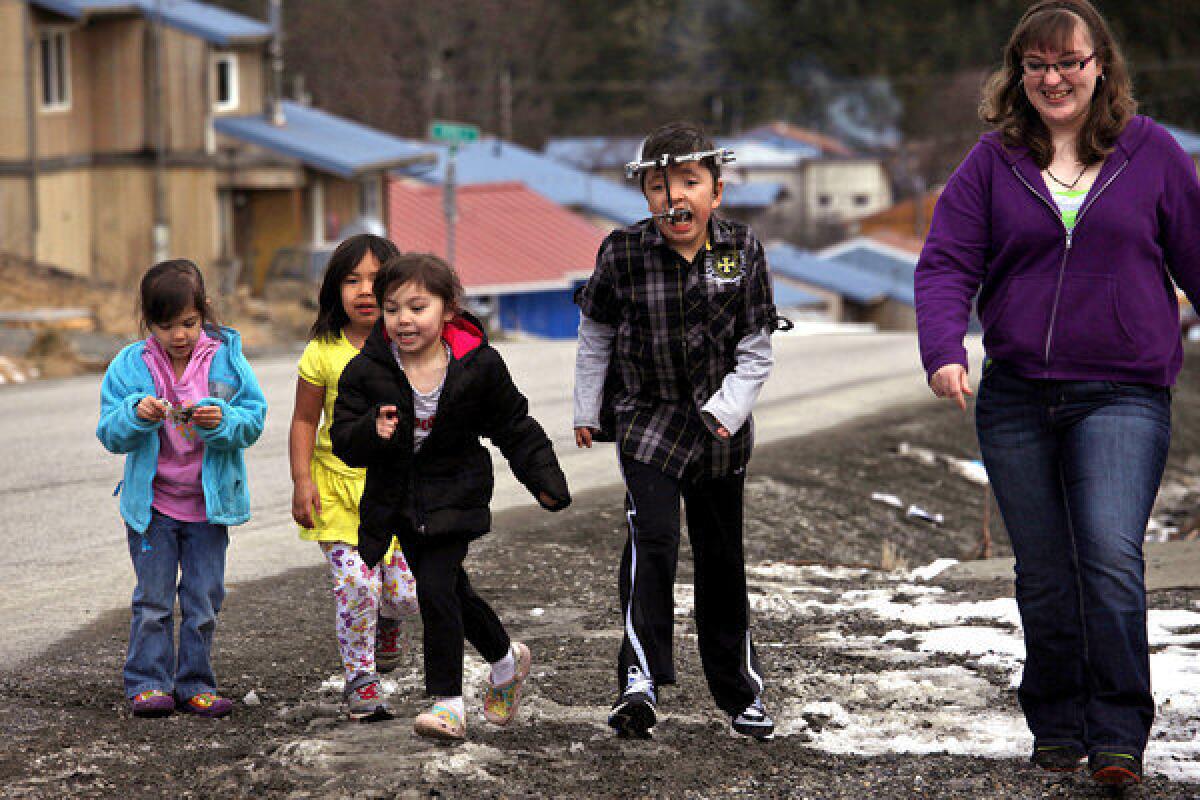
James, second from right, and other children run alongside teacher Johanna Lambeth before attending Bible study class at the Salvation Army Church. More photos
Most people here don't seem to notice James' appearance, or are sidetracked by his infectious good humor. Johnny Roberts says he got to know James the day he confronted some boys who were bullying him. "He came over and gave me a big hug, and we've been good friends ever since," Johnny says.
One recent afternoon, the boys meet their friend Amber and run up to the park where 21 majestic Tlingit totem poles stand overlooking the village.
"Hey, Johnny, how old are you?" James says presently.
"I told you, don't call me Johnny. Call me John-John."
"Hey John-John. How old are you?"
"You already asked me that a million times. I told you: 14."
"How old are you?"
"I'm old enough to get out of Alaska," Johnny says as he sighs. "I've seen enough of Alaska. I've seen 14 years' worth of Alaska."
They wander down to the dock, where James' uncle is getting his boat ready to go fish for halibut. A bald eagle glides overhead.
"Hi, eagle!" James shouts, craning his neck back awkwardly because his eyelids can't open far enough to see the sky otherwise. "Can I hop on your back, so I can fly?"
Johnny throws rocks into the water. James watches, then grows bored. "Oh, my feet want to walk to the ball park!" he announces.

Weatherwax left James' father when he made it clear he'd never accept a child so badly deformed. She married again and had two more children, but her husband was jailed recently for driving drunk and crashing his car.
"If you want to know what Kecia's life is like, I would use the word hell," says her father, Williams. "Put yourself in her shoes. You're way the hell up here, far away from the hospital, trying to keep your head up high, keep a job, raise the kids, OK? And then at the same time think, 'I wonder if my son's going to have a heart murmur, what about moving his cheeks, how is he going to work with those hands?'"
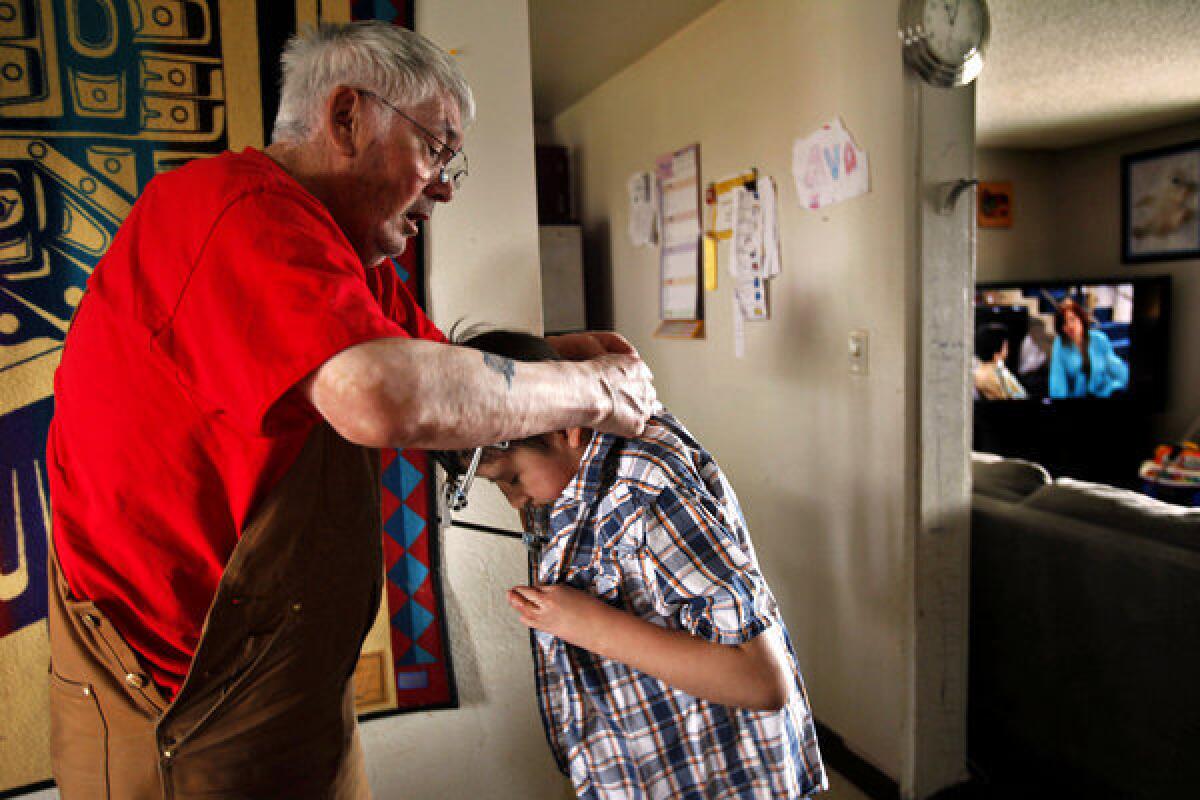
Jim Williams, 74, helps his grandson James put on his shirt at their home. "His grandpa really ... babies him," says James' mother, Kecia. "I get mad at my dad because I don't want him being too dependent." More photos
Williams, at 74, finds himself trying to be a parent to his young grandchildren while his daughter focuses on James.
When Weatherwax retreats to her room to read or spends an hour at the market just to get out of the house, Williams chases 1-year-old Abby around the living room. He heats up pizza rolls in the microwave for James, turns on "Wizards of Waverly Place" on TV and puts on another pot of coffee to keep going.
"I'm retired. I'm supposed to be having two, three girlfriends calling me — 'I'll take you to the beach, I'll take you to dinner tonight!' And here I am changing diapers," he says.
These days, Williams and James — who's a precision passer and a decent dribbler despite having no knuckles — are a fixture at the local high school basketball games. The gym, during the dark, snowy winters, is the town's central gathering point.
In March, the Klawock high school team won the Class 1A state basketball championship and most of the town turned out to greet the players on their return from Anchorage, forming a parade behind the firetruck and ambulance toward the Alaska Native Brotherhood hall.
Williams lifts James into the back of his pickup. He fastens his coat.
"Holy cow! I feel like I'm going to be super speeding!" James shouts into the night.
"Put your hood up, son," Williams says.

Last fall, Dr. Richard Hopper, head of the craniofacial surgical team at Children's Hospital in Seattle, said James was ready for a landmark procedure he'd developed that had the ability, unlike previous surgical corrections for Apert patients, to transform James' face into one that looks like any other boy's.
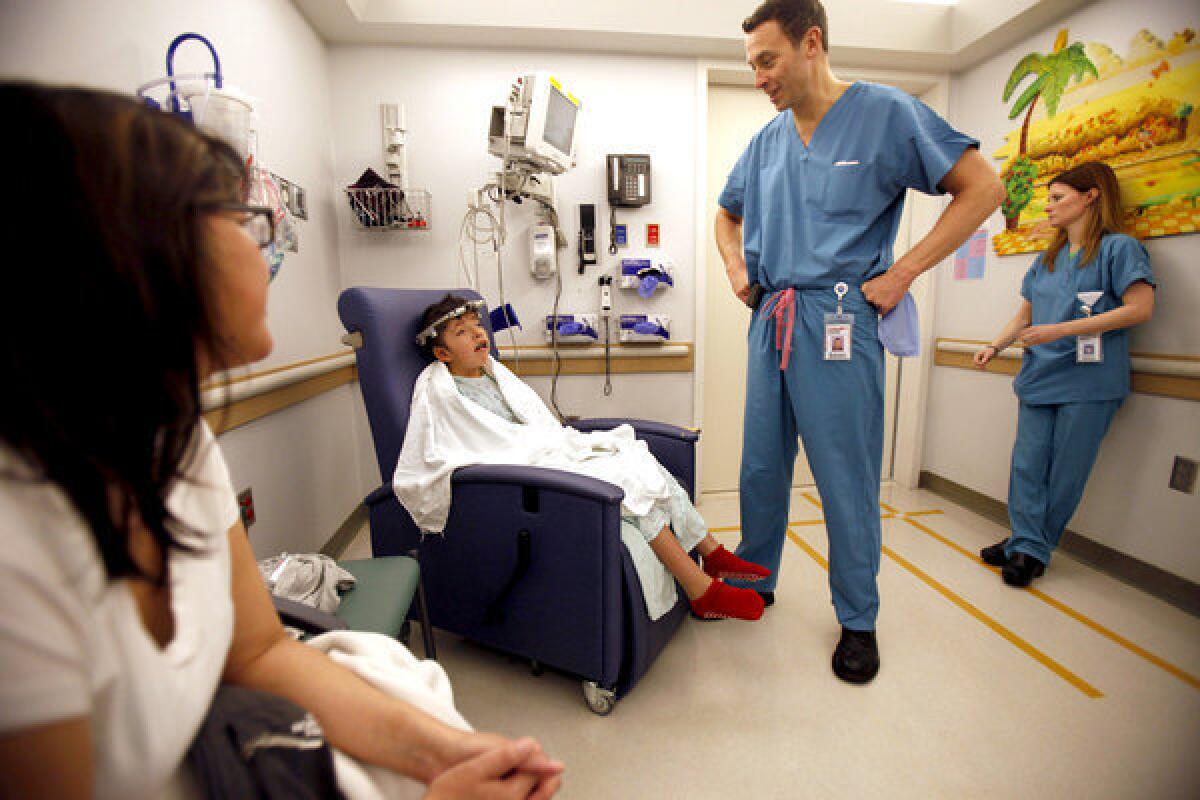
Dr. Richard Hopper, head of the craniofacial center at Children's Hospital in Seattle, visits with James and his mother before operating on the youngster to remove the metal brace. More photos
But it would involve a procedure so intense Weatherwax could hardly bear to imagine it. They would slice open the top of his scalp, peel his face down to his jaw, and take saws and chisels to the underlying bones, pounding them into a more recognizable shape before folding and sewing the skin back into place. They would insert a plate where he had no forehead, build protective sockets for his eyes, pull the bones back from his airway.
Finally, they would attach a metal brace known as a halo to his head and teach Weatherwax how to turn the bolts with a screwdriver twice a day to slowly stretch the bones of his face apart.
James underwent the daylong procedure in January, and the transformation has been astonishing. From the awkward, bug-eyed visage that once drew stares has emerged a winsome boy who few would guess had lived through a 10-year craniofacial ordeal.
We're never done. Do you know that? We're never done."— Kecia Weatherwax
Weatherwax returns to Seattle in late March with her son for the big reveal — the removal of the head brace — and James is sitting tensely as a nurse offers him a soothing pre-op sedative that James and Weatherwax have come to call "the pink stuff."
He quickly recoils. "It'll make you feel really giggly, OK?" the nurse says. "I'll bet you're a kid who likes to laugh."
James starts crying.
"Calm down," Weatherwax says. "Think about going home tomorrow."
"I want Grandpa," James wails.
Then Weatherwax starts crying too. "You're all right. Just close your eyes. Think about Grandpa."
She gets up, walks to the other side of the room and impatiently wipes the tears off her face so he won't see them. Her legs are shaking. "I've been through this so many times, I'm thinking I want that pink stuff," she says.
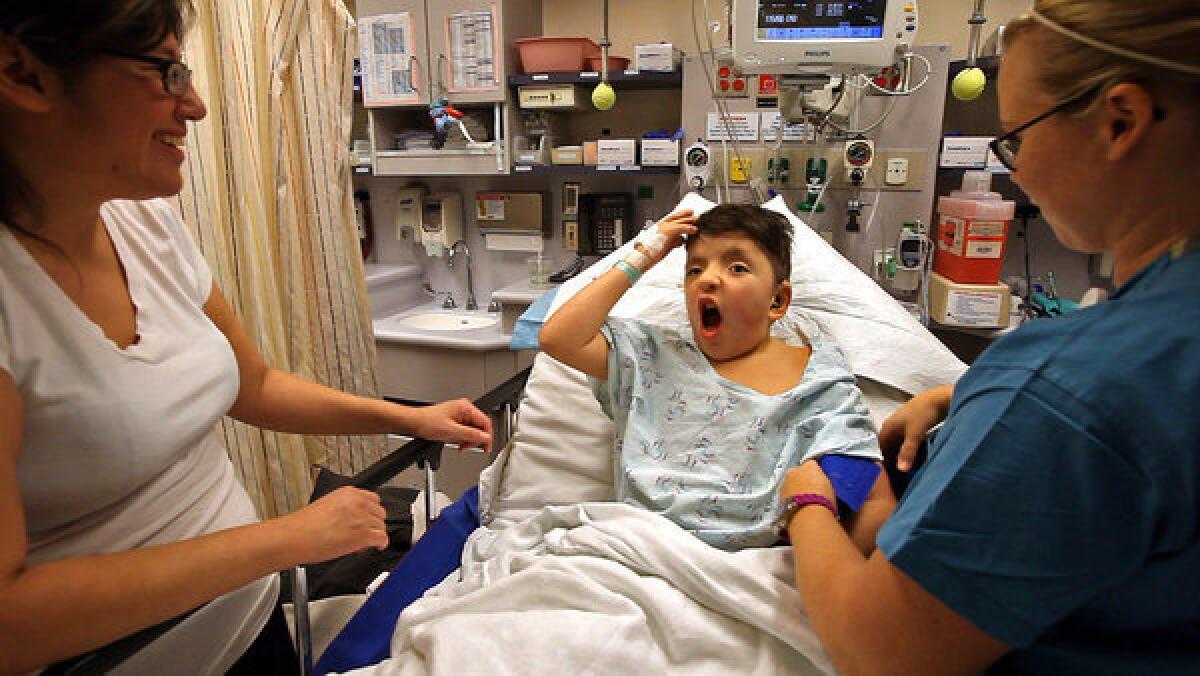
After his surgery, James expresses surprise at finding the halo gone as his mother, Kecia, left, looks on at the hospital in Seattle. More photos
The procedure itself takes only an hour or so, and afterward, Hopper comes to check on him as James slowly awakens. "Basically, it's over," he says to Weatherwax. "He can get back to his life, and you can get back to yours."
Of course, it's not really over. The ophthalmologist has suggested two additional surgeries, and perhaps when he's 18, he will need yet another operation to correct the alignment of his jaw.
"We're never done," Weatherwax says. "Do you know that? We're never done."
James touches his nose, his cheeks, his jaw, measuring how they feel without a metal ring around his head. "Momma, when we were over there in the waiting room? I was dreaming about something," he says.
"What were you dreaming about?" she asks.
"Heading home."
Follow Kim Murphy (@kimmurphy) on Twitter
Sign up for Essential California
The most important California stories and recommendations in your inbox every morning.
You may occasionally receive promotional content from the Los Angeles Times.







